SAMURAI SWORD 25 - WWII Masakuni blade
The sword featured here is a hand made blade made by master Masakuni during WWII. It is mounted on the standard
Jaanese Imperial army attire.
When attempting to identify a sword, it is important to note that the external components of the sword (handle, Tsuba, scabbard, etc.) are all going to be identical if the sword was outfitted in WWII attire. Just because the external apperance looks the same as the Koto blade shown here does not mean that the sword is a Masakuni blade.
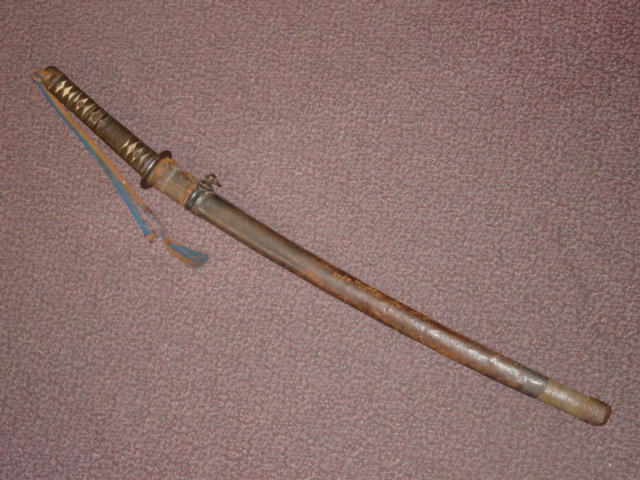
The scabbard consists of a metal outer shell covering a wooden insert. In this example the scabbard is covered
with a brownish leather cover. This was a traditional mountings for Army swords during the WWII period. The
throat area shows a metal band which holds the single suspension ring for the sword.
A leather belt was passed through the ring which was then secured to the uniform. That was the official way to
carry the sword. However, many soldiers did not use this approach, they borrowed a technique that dates back
to the days of the Samurai and wore the sword slung across the pants belt. Towards the front.
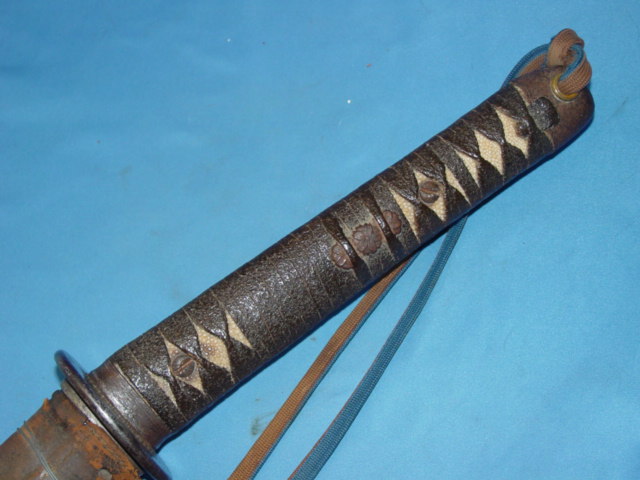
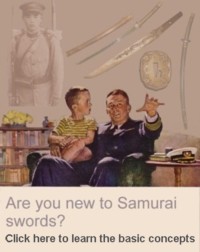
|
The Samurai sword has a very rich history. The sword has been manufactured for several centuries and continues
to be produced today. The sword represented more than just a weapon. It was the soul of the Samurai warrior.
When attempting to identify the type of sword you have It is important to keep in mind that the fittings of
a sword (scabbard, handle, crossguard. etc.) may be identical from one sword to another. The reason why is
because during WWII the same fittings were used in all Army swords, Navy swords, etc. Armed forces are all
about uniformity. They strive to make everything the same.
This is the reason why a sword cannot be identified merely by its external appearance.
Understanding the different components that make up the Samurai sword is the first step in figuring out the
type of sword you have. That is the reason why we have created the
Understanding the Samurai sword section as a means to
provide a novice with the basic knowledge to start the path of determining the questions everyone has;
who made the sword, how old it is nad how much it is worth.
|
The handle of the sword is wrapped with a dark brown cloth. This particular example was dipped into a
weater-proofing chemical that protected the material in the wet conditions of the islands in the South
pacific. The wooden handle was covered by a white ray skin which had a bumpy texture.
The three cherry blossom menuki is also a typical mounting of the japanese armed forces
during WWII. The menuki is often a highly decorative piece portraying figures of dragons,
skulls, insects and many other characters. The picture on the right illustrates the "tachi" hardware.

Every time the sword is placed in its sheath a locking mechanism automatically activated. This was a safety feature
designed to prevent the sword from falling off the scabbard.
The locking mechanism release consists of a small metal button placed at the base of the handle. A metal ring had a
hole which allowed the buttonn to pass through. Pressing the button woudl disengage the lock and allow the sword
to be pulled out of the scabbard.
The metal ring is adorned with a flower pattern which is applied to its surface.
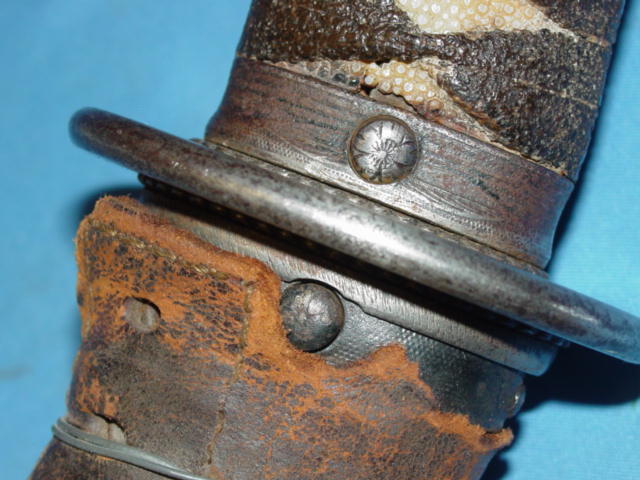
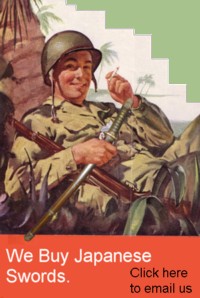
|
WE BUY JAPANESE SWORDS - All types of Japanese edge weapons. Whether it is a WWII era Samurai sword or an
older type of blade.
The process gets started by you sending us an
Email .
We will respond to your inquiry normally within 24 hours and in many cases much faster.
We can tell you what you have, what it is worth and how much we can pay you.
One sword or an entire collection -
Email Us .
|
 |
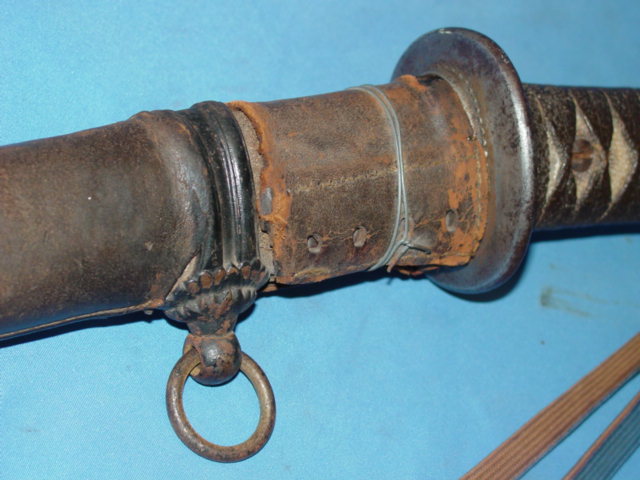
The handle of the sword is normally secured to the tang via the use of one or two wooden pegs. The sword featured
here uses a different mechanism. The following photo shows that screws were employed as replacement for the wooden
pegs. This technique is seen on battlefield swords.
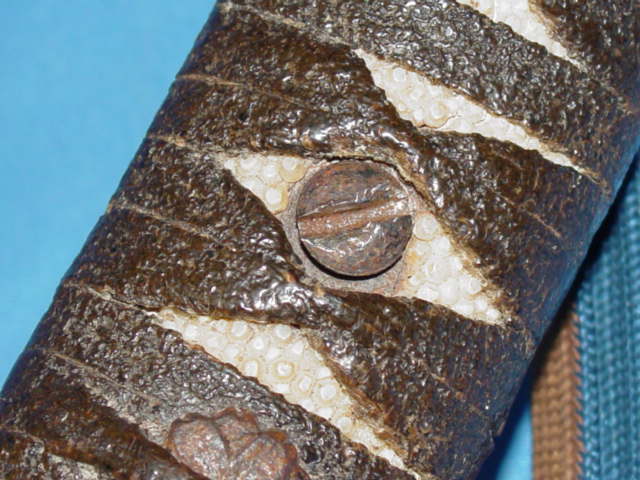
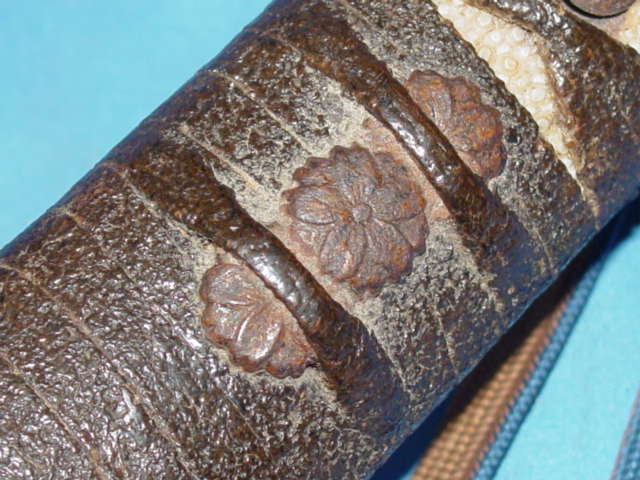
|
This page is a recognition and identification guide for Samurai swords.
Multiple detailed photos of a specific sample are provided. Descriptions point
out clearly defined points that should be noted.
One of the most commonly asked questions is "How much is my Samurai Sword worth?".
A price guide is included here to address this question. The value of the swords is
reviewed over a period of several years. A trend can be observed. The present worth
of the edge weapons in the collector's market is illustrated.
This service is provided free of charge to the visitor/enthusiast courtesy of
MilitaryItems.com,
a company dedicated to the preservation of military history and to providing quality
military antiques and collectibles to museums, institutions and the general public.
|
|
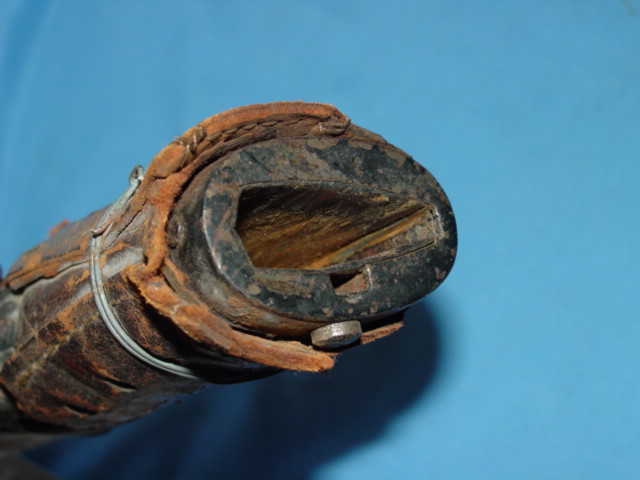
The tip shows a small nick. This is the most dangerous part of the sword during a fight and by default the section
that gets the most damage.
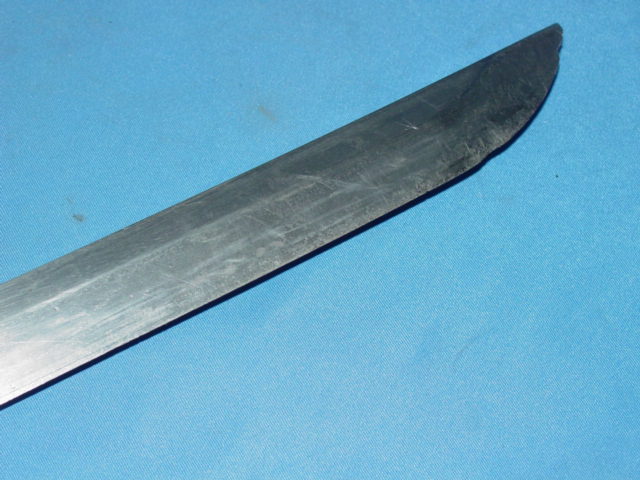
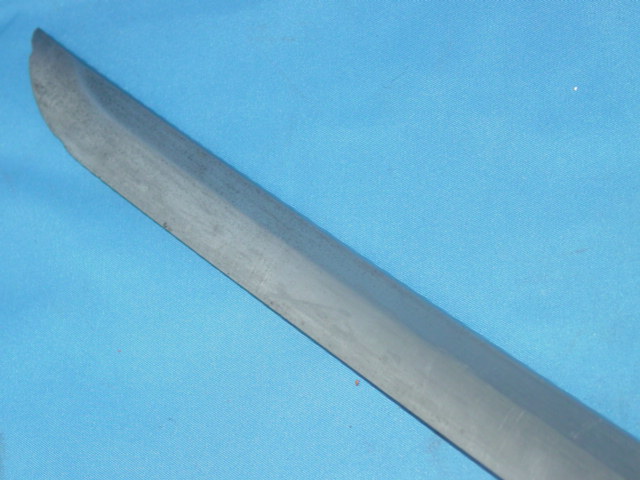
The Tang has two holes drilled into it. This is where the wooden pegs are placed to secure the handle to the sword.
The end of the Tang is rounded. The sword was not shortened. It retains the original length it had when it was
manufactured.
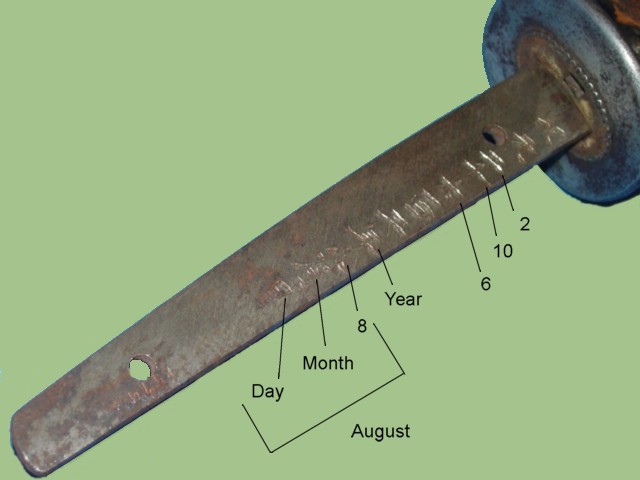
The sword has markings on two sides. One side has the date information while the other shows the signature of the
master who made the sword.
A translation of the date indicates the sword was made on the month of August.
The following photo provides a closer view of the markings.
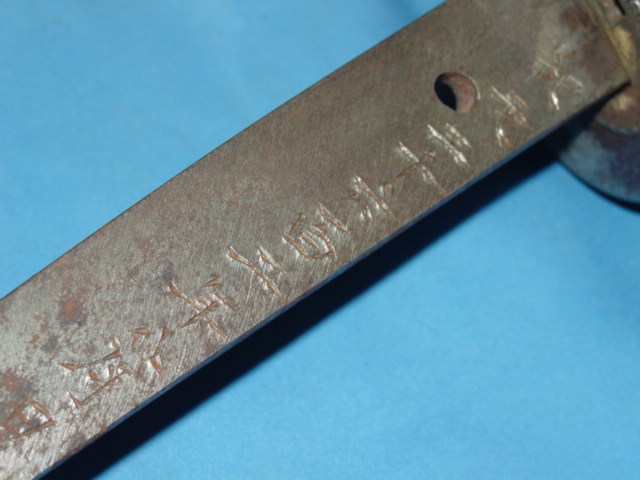
this is the Masakuni's signature.
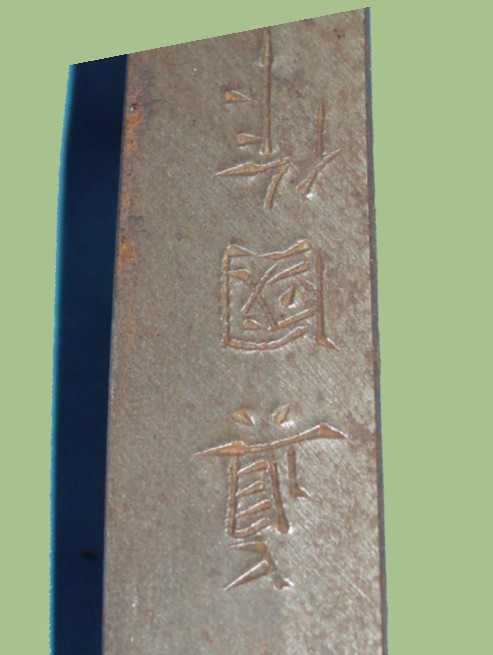
This is a photo of the tassle which is attached to the pommel area of the sword. This example is not complete. One of
the ends is missing. The tassle indicated an officer rank. One side was dark brown and the other side was blue.
Not all swords came with tassles.
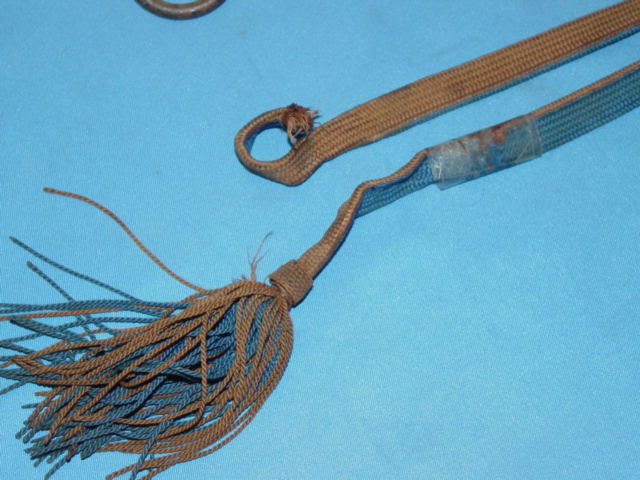
The tip of the scabbard is missing some of the leather cover. This was a common problem as the tip was dragged
on the ground and suffered the most damage during combat.
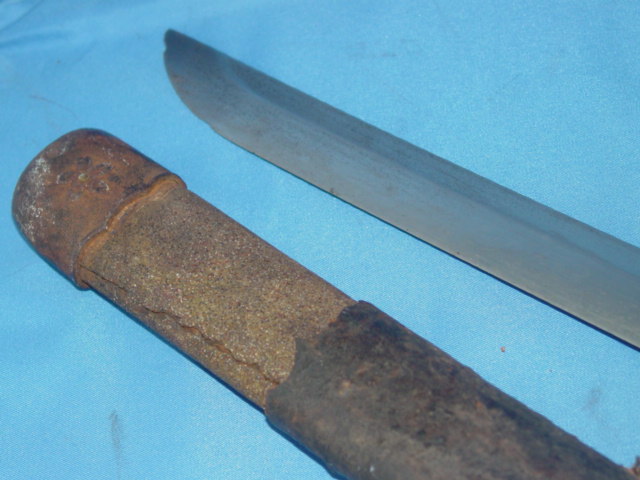
By the Numbers
It is next to impossible to determine the exact number of Samurai swords that were produced and issued to
Japanese soldiers during the war. However, thanks to the record keeping maintained by the US Armed Forces,
it is possible to estimate how many swords were actually shipped home.
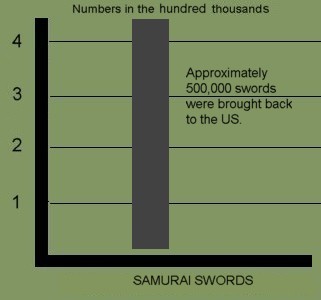 |
There were over 500,000 Samurai swords were brought back home as souvenirs from the war.
There are several caviats to this number.
|
 |
For example, some soldiers took souvenirs and shipped them home circumbenting the established process.
Some of the swords were brought back inside duffle bags without anyone knowing except for the soldier who
captured the sword. This fact would clearly affect the final count.
The number also does not account for swords that were taken by Allied soldiers from other countries.
Collecting Samurai swords
Collecting Samurai swords is a field that has been growing since the days the GI's rummaged around Asia
bringing back military souvenirs. Japanese soldiers carried many of these swords when they went to
battle. Once the soldier was killed or captured, the Americans would take the edge weapons as war trophies.
Eventually all these pieces came back to the United States where military history enthusiasts began to collect them.
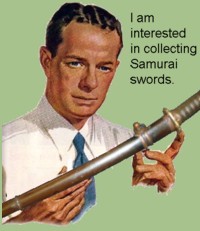 |
In trying to determine if you should collect Samurai swords there are certain factors that should be
considered.
The adjacent table outlines some of the advantages and disadvantages of collecting the Samurai swords.
|
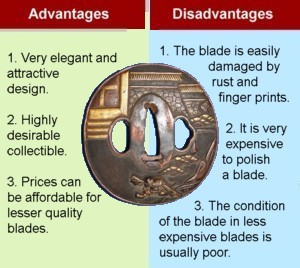 |
This Samurai Sword may be currently reproduced.
It is becoming more difficult to be able to tell the fake ones from the real ones because
the quality of the reproductions is improving. The collector must become familiarized with
the construction style and materials employed in the manufacturing of this item.
Attention to the details is critical in order to be able to determine the authenticity of
the collectible.
If you have an interest is seeing other Japanese Samurai swords, you can do so by going to our
Japanese Samurai Swords Price Guide
identification guide. Where we cover Samurai swords from all periods.
| 




